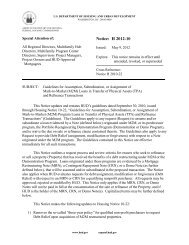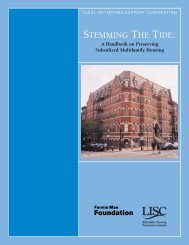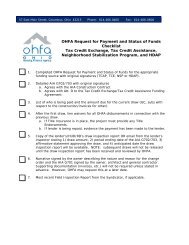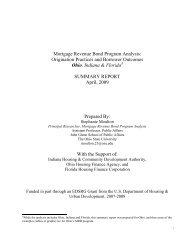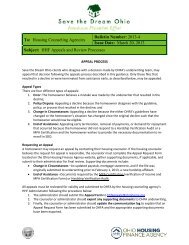• Purchase and rehabilitate homes and residential properties that have been abandonedor foreclosed upon, in order to sell, rent or redevelop such homes and property;• Establish land banks for homes that have been foreclosed upon;• Demolish blighted structures; and• Redevelop demolished or vacant properties (including new construction).Land Banks/Demolition• Establish land banks for homes that have been foreclosed upon; and• Demolish blighted structuresAffordable Rental <strong>Housing</strong> Initiative• Purchase and rehabilitate homes and residential properties that have been abandonedor foreclosed upon, in order to sell, rent or redevelop such homes or property; and• Redevelop demolished or vacant properties.The <strong>Ohio</strong> Department of Development recently published for public comment the Draft FY2008 <strong>Ohio</strong> Consolidated <strong>Plan</strong> Amendment: Action <strong>Plan</strong> for the Neighborhood StabilizationProgram (NSP). In this document, ODOD announced plans to allocate $116,859,223of NSP funds by April 1, 2009. Of these funds, ODOD will allocate 10 percent towardsadministration with 60 percent of those funds allocated to award recipients. Another 25percent ($29,214,900) will be allocated as a rental reserve through an Affordable Rental<strong>Housing</strong> Initiative (ARHI). The ARHI will encourage the redevelopment of demolished,foreclosed or vacant structures into affordable rental housing serving households withincomes at or below 50 percent of area median income and provide additional resources toboth the <strong>Ohio</strong> NSP direct award recipients, where vacant rental properties are abundant, aswell as in rural communities through a nonprofit organization.Key features of note include a requirement of a minimum discount of 15 percent for eachresidential property purchased with NSP funds and the finance mechanism for any directassistance to homebuyers will be in the form of zero percent interest loans, which may bedeferred and forgiven over time.ODOD will mitigate the loss of low- and moderate-income housing units demolished,rehabilitated or converted with <strong>Ohio</strong> NSP funds by requiring housing units to be vacant atleast 90 days prior to the purchase of a unit for demolition, rehabilitation or conversion.In addition, <strong>Ohio</strong> NSP award recipients may only acquire property through voluntaryacquisition.ODOD will address eligible applicants with the balance of funds by compiling a list of <strong>Ohio</strong>’scounties, 35 entitlement cities and those <strong>Ohio</strong> cities eligible to receive <strong>Ohio</strong> Small CitiesCDBG funds, including direct NSP recipients, and rank jurisdictions in order of need basedon an established formula described in ODOD’s proposed amendment to the Consolidated<strong>Plan</strong>. This formula uses FACL foreclosure data, 2000 Census, subprime loans and rates,defaults and rates, delinquencies and rates and USPS vacancy rates.Based on the ranking resulting from application of the formula, ODOD will determine if andhow much in additional funds should be allocated to direct NSP recipients. After subtractingthe amount allocated to direct NSP recipients, ODOD will award the balance to <strong>Ohio</strong>’s othereligible jurisdictions. The <strong>Ohio</strong> NSP funds, except those awarded for ARHI, will be awardedto eligible program applicants through an application process to assist persons/familieswith incomes at or below 120 percent of the area median income. Full applications will be98
distributed on or about January 15, 2009 with applications due on or about February 27,2009. Funds will be allocated by April 1, 2009, the projected start date for the program. Theprojected end date is March 30, 2013.The NSP funds will supplement current initiatives underway in cities and non-metro areasthroughout the State of <strong>Ohio</strong> that in many cases are under-funded and generally underresourced.Foreclosure Prevention: The State of <strong>Ohio</strong> has taken steps to increase resources available toprevent future foreclosures within cities. The <strong>Ohio</strong> Foreclosure Prevention Task Force, FinalReport published September 10, 2007 presented seven recommendations to decrease thenumber of future foreclosure fillings. The recommendations included:• Encourage borrowers to get help early• Expand <strong>Housing</strong> Counseling and Intervention Services• Work with Lenders and Servicers to Maximize Alternatives to Foreclosure• Provide Options for Homeowners to Refinance or Restructure Their Mortgages• Improve <strong>Ohio</strong>’s Foreclosure Process• Strengthen Protections for Homeowners• Help Communities Recover from the Aftermath of ForeclosuresWe encourage the State of <strong>Ohio</strong> to continue to actively work towards achieving eachrecommendation and providing local jurisdictions with Best Practices for implementation. Weapplaud the implementation of programs such as “Save the Dream” that directly respond tothe need for foreclosure prevention.Energy and Mobilization: The issue of vacant housing has spurred the interest of numerousgroups, organizations, lawmakers, jurisdictions and the media. Great efforts are takingplace by ReBuild <strong>Ohio</strong>, Greater <strong>Ohio</strong>, cities, counties, CDCs and CHDOs, and the <strong>Ohio</strong>General Assembly. The State of <strong>Ohio</strong> should garner this energy to create comprehensivestrategies to addressing vacant property.Resource Inventory:Programs that address vacant housing needs:1) Neighborhood Stabilization Program: As described above, <strong>Ohio</strong> will receive $258 millionfor selected entitlement and the State of <strong>Ohio</strong> Program. Funds are distributed by the USDepartment of <strong>Housing</strong> and Urban Development as part of a short term stimulus packageapproved by Congress and the President.This resource will give a major boost to efforts to demolish, renovate and rebuild devastatedcommunities throughout the state. Funding must be committed within 18 months and spentwithin three years.2) The <strong>Ohio</strong> <strong>Housing</strong> <strong>Finance</strong> <strong>Agency</strong> provides financing for rehabilitation of vacant housingthrough the <strong>Housing</strong> Credit Program, <strong>Housing</strong> Development Assistance Program and<strong>Housing</strong> Development Gap Financing. While vacant homes comprise a minority of the fundedprojects, <strong>OHFA</strong> has increased incentives over the last few years to encourage projectsfocusing on rehabilitation of existing apartments and homes.3) The <strong>Ohio</strong> Community Development <strong>Finance</strong> Fund has a $1 million loan pool for acquisitionand holding costs (LANDLOC) from the <strong>Ohio</strong> <strong>Housing</strong> Trust Fund. Nonprofit CDCs and CHDOscan apply for funding at this time.99
- Page 3 and 4:
OHFA Annual PlanThe Ohio Housing Fi
- Page 5:
Mission StatementsThe OHFA Annual P
- Page 8 and 9:
The State’s Housing NeedsAffordab
- Page 10 and 11:
Subject Matter Expert (SME) Workgro
- Page 12 and 13:
3. Financial LiteracyOHFA and other
- Page 14 and 15:
Affordable Housing Preservation & D
- Page 16 and 17:
federal subsidies. To achieve this
- Page 18 and 19:
Accessible HousingBackground DataOh
- Page 20 and 21:
3) Create dedicated funding streams
- Page 22 and 23:
• Recommend that Ohio support the
- Page 24 and 25:
Rural and Appalachian RegionsBackgr
- Page 26 and 27:
6. Annual Set-Asides and Incentives
- Page 28 and 29:
• Several cities in Ohio current
- Page 30 and 31:
OHFA should provide funding, traini
- Page 32 and 33:
Permanent Supportive Housing Produc
- Page 34 and 35:
3. The State should assist local Co
- Page 45 and 46:
PrioritizationThe challenge of prio
- Page 47 and 48: Agency RecommendationsThe Annual Pl
- Page 49 and 50: APPENDIXWorkgroup 1: Affordable Hom
- Page 51 and 52: Executive SummaryHousing Need Descr
- Page 53 and 54: efficiency and resource conservatio
- Page 55 and 56: 554. Home Buyer Education in OHFA F
- Page 57 and 58: Estimated Units in Need of Some For
- Page 59 and 60: Ohio County Foreclosure Filings (19
- Page 61 and 62: Operating Costs - Met and Unmet Nee
- Page 63 and 64: Workgroup #2:Affordable Housing Pre
- Page 65 and 66: Secondary Recommendations• Explor
- Page 67 and 68: Executive SummaryOhio’s supply of
- Page 69 and 70: Met Housing Needs (“Resource Inve
- Page 71 and 72: Ohio Deptof MentalRetardation andDe
- Page 73 and 74: Unmet Housing NeedsData OverviewThe
- Page 75 and 76: ody, and will be built within the C
- Page 77 and 78: • OHFA will continue to maintain
- Page 79 and 80: Best Practices, Policies and Progra
- Page 81 and 82: addition, 60,111 one-person househo
- Page 83 and 84: Across Ohio, people with very low i
- Page 85 and 86: • Responsible for Rent - The pers
- Page 87 and 88: Seattle, St. Louis, and Washington,
- Page 89 and 90: Primary Recommendations• Create a
- Page 91 and 92: Unmet Housing Needs:• Due to the
- Page 93 and 94: • The cost of construction often
- Page 95 and 96: Recommendations for Annual Plan Adv
- Page 97: capacity to quantify vacant propert
- Page 101 and 102: Action is needed at the State level
- Page 103 and 104: a “user-friendly” data system,
- Page 105 and 106: 5) Incentivize the formation of bro
- Page 107 and 108: Workgroup #8:Permanent Supportive H
- Page 109 and 110: 3. Assist local Continuums of Care
- Page 111 and 112: Program and Resource InventoryNonpr
- Page 113 and 114: Table 2PopulationsPersons whoexperi
- Page 115 and 116: Examples: A national model for succ
- Page 117 and 118: oles, so they create a contract bet
- Page 119 and 120: Workgroup #8:Appendix ANameProgramD
- Page 121 and 122: or remedyingneglect, abuse,or the e
- Page 123 and 124: ased healthcare, and earlyintervent
- Page 125 and 126: “Bob” of Stark County, OhioPubl



